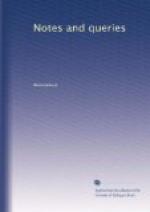Has this inscription ever been explained, and how? Stukeley’s book is by no means a rare one; therefore I have not trusted myself to copy the inscription: and such as feel disposed to help me in my difficulty would doubtless prefer seeing the Doctor’s own illustration at p. 31.
Henry Cunliffe.
Hyde Park Street.{120}
ATHELSTANE’S FORM OF DONATION.—MEANING OF “SOMAGIA.”
Tristram Risdon, in his quaint Survey of the Co. of Devon, after mentioning the foundation of the church of High Bickington by King Athelstane,
“Who,” he says, “gave to God and it one hide of land, as appeareth by the donation, a copy whereof, for the antiquity thereof, I will here insert: ’Iche Athelstane king, grome of this home, geve and graunt to the preist of this chirch, one yoke of mye land frelith to holde, woode in my holt house to buyld, bitt grass for all hys beasts, fuel for hys hearth, pannage for hys sowe and piggs, world without end,’”—
adds presently afterwards, that
“Sir John Willington
gave Weeksland in this tything, unto
Robert Tolla, cum 40 somagia
annuatim capiend in Buckenholt
(so be the words of the grant)
in the time of K. Edw. I.”
The Willingtons were lords of the manor of Umberleigh, where Athelstane’s palace stood, with its chapel dedicated to the Holy Trinity, formerly rich in ancient monuments, and having a chantry near to it. Some of the monuments from this chapel are still preserved in the neighbouring church of Atherington.
My Queries upon this Note are:
1. Whence did Risdon derive his copy of King Athelstane’s form of donation? 2. What is the precise meaning of the word Somagia?
In Ducange (ed. Par. 1726, tom. vi. col. 589.) I find:
“Somegia. Praestatio, ut videtur ex summis, v. gr. bladi, frumenti. Charta Philippi Reg. Franc. an. 1210. Idem etiam Savaricus detinet sibi census suos, et venditiones, et quosdam reditus, qui Somegiae vocantur, et avenam, et captagia hominum et foeminarum suarum, qui reditus cum una Somegiarum in festo B. Remigii persolverentur; deinde secunda Somegia in vicesima die Natalis Domini, et tertia in Octabis Resurrectionis Dominicae, ei similiter persolventur; caponum etiam suorum in crastino Natalis Domini percipiet solutionem: unaquaeque vero somegiarum quatuor denarios bonae monetae valet.”
Ducange refers also to some kindred words; but, instead of clearing up my difficulty in the word somagia, he presents me with another in captagia, the meaning of which I do not clearly understand. Perhaps some of your more learned contributors will obligingly help me to the true import of these words?




